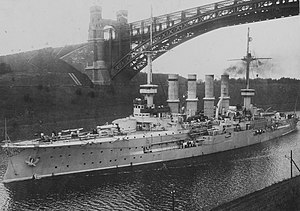Our website is made possible by displaying online advertisements to our visitors.
Please consider supporting us by disabling your ad blocker.
SMS Roon
 SMS Roon in the Kaiser Wilhelm Canal, c. 1910
| |
| History | |
|---|---|
| Name | Roon |
| Namesake | Albrecht von Roon |
| Builder | Kaiserliche Werft, Kiel |
| Laid down | 1 August 1902 |
| Launched | 27 June 1903 |
| Commissioned | 5 April 1906 |
| Decommissioned | 22 September 1911 |
| Commissioned | 2 August 1914 |
| Decommissioned | 4 February 1916 |
| Stricken | 25 November 1920 |
| Fate | Scrapped 1921 |
| General characteristics | |
| Class and type | Roon-class armored cruiser |
| Displacement | |
| Length | 127.8 m (419 ft 3 in) |
| Beam | 20.2 m (66 ft 3 in) |
| Draft | 7.76 m (25 ft 6 in) |
| Installed power |
|
| Propulsion |
|
| Speed | 21.1 knots (39.1 km/h; 24.3 mph) |
| Range | 4,200 nmi (7,800 km; 4,800 mi) at 12 knots (22 km/h; 14 mph) |
| Crew |
|
| Armament |
|
| Armor | |
SMS Roon[a] was the lead ship of her class of armored cruisers built for the German Kaiserliche Marine (Imperial Navy) in the early 1900s as part of a major naval expansion program aimed at strengthening the fleet. The ship was named after Field Marshal Albrecht von Roon. She was built at the Kaiserliche Werft in Kiel, being laid down in August 1902, launched in June 1903, and commissioned in April 1906. The ship was armed with a main battery of four 21 cm (8.3 in) guns and had a top speed of 20.4 knots (37.8 km/h; 23.5 mph). Like many of the late armored cruisers, Roon was quickly rendered obsolescent by the advent of the battlecruiser; as a result, her career was limited.
Roon served in I Scouting Group, the reconnaissance force of the High Seas Fleet, for the duration of her peacetime career, including several stints as the flagship of the group's deputy commander. During this period, the ship was occupied with training exercises and made several cruises in the Atlantic Ocean. In 1907, she visited the United States to represent Germany during the Jamestown Exposition. In September 1911 she was decommissioned and placed in reserve.
Three years later, the ship was mobilized in August 1914 following the outbreak of World War I and assigned to III Scouting Group, serving initially with the High Seas Fleet in the North Sea. There, she escorted the main German fleet during the raid on Yarmouth in November and the raid on Scarborough, Hartlepool and Whitby in December, though she saw no action during either operation. She was transferred to the Baltic Sea in April 1915 and took part in several operations against Russian forces, including the successful attack on Libau in May and the failed attack on Riga in August. The threat of British submarines convinced the German command to withdraw old vessels like Roon by early 1916, and she was again decommissioned and eventually used as a training ship. Plans to convert her into a seaplane tender in 1918 came to nothing with the end of the war, and she was broken up in 1921.
Cite error: There are <ref group=lower-alpha> tags or {{efn}} templates on this page, but the references will not show without a {{reflist|group=lower-alpha}} template or {{notelist}} template (see the help page).
Previous Page Next Page


